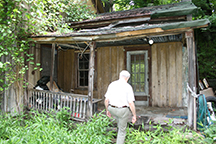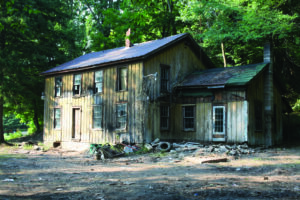 In March of 2011, Walter and Marilyn Barbe made the largest contribution to the Dorflinger-Suydam Wildlife Sanctuary since it began when they gifted the restored Lock Tenders House in White Mills. The D & H Canal was used by C. Dorflinger & Sons to bring raw materials to the factory and to send completed glass to New York. It is an important piece of the heritage of Dorflinger glass and the village of White Mills. Museum Curator Hank Loftus recounts how the Lock House came to be saved.
In March of 2011, Walter and Marilyn Barbe made the largest contribution to the Dorflinger-Suydam Wildlife Sanctuary since it began when they gifted the restored Lock Tenders House in White Mills. The D & H Canal was used by C. Dorflinger & Sons to bring raw materials to the factory and to send completed glass to New York. It is an important piece of the heritage of Dorflinger glass and the village of White Mills. Museum Curator Hank Loftus recounts how the Lock House came to be saved.
CONDEMNED—is what the bright, orange signs tacked to the side of the old building said. As Dr. Walter Barbe made his way to the door on the side porch, I reminded him that we were trespassing. Beside that, the door is probably locked I said as Dr. Barbe turned the knob and pushed it in. Oh well, I thought as I followed him into what was the kitchen, when we are arrested, the newspapers will use his name in the headline, not mine.

Old Lock House
Like the building’s exterior, the kitchen had seen better days. Between the peeling paint and clutter, it was hard to get a sense of the building’s condition. Did I mention the clutter? I have a high tolerance for it but this was really cluttered. Old furniture, old carpeting, old papers, old cans, old stuff, and even more stuff—the room was full.
As we picked our way through to the next room, he wanted to go on but I reminded him it would get darker as we moved further into the house and we did not have flashlights. He pointed to the light bulb dangling from the ceiling and asked if I saw a light switch. I reminded him the building was condemned and that it was highly unlikely the electricity would still be turned…CLICK…he found the switch and the bulb brightened to illuminate another room filled with…clutter. Even Pennsylvania Power & Light must have a hard time finding Lock Street with a shut-off order.
The living room with its single bulb had large, faded squares and rectangles on the walls where frames had been removed. Surprisingly, the paint on the walls was in good shape and the floors, walls, and ceilings seemed solid.
I tried to photograph each room from several angles to document the building before it was demolished. The rooms in the back of the house had less light from windows and not so much stuff. The lack of light was a blessing. The two major rooms on the second floor had plenty of windows albeit with missing and broken panes. The view was of the Lackawaxen River and a pleasant surprise.
We were both struck with how well proportioned the whole building seemed to be. It just felt right, a good space. Standing in the upstairs rooms, overlooking the river, it was easy to imagine the lock tender and his family in the same spot watching boats filled with coal entering the lock of the Delaware and Hudson canal, passing by the house just outside the front door.
After we managed to photograph as much of the house’s interior and exterior as we could, Dr. Barbe wondered if he should check to see if the house could be saved. Given his track record in saving historic houses in White Mills, of course I said yes.
Within a day or two he knew the backstory of how it came to be put up for sale, had not found a buyer and would be condemned and likely demolished. He called upon his friends in the legal and real estate worlds—they had to be friends because it was unlikely this real estate deal was going to generate much in the way of any commission.

Lock House Today
In short order he purchased the house and began its restoration. With the support of his wife, Marilyn, (who I am certain made him promise to only own one house in White Mills at any given time) and many friends, Dr. Barbe completed the restoration of the building. In one half he made an apartment. In the other half, he installed a museum with exhibits on the Delaware and Hudson Canal.
The restored house and museum opened with a gala reception and open house in September 2008. It was hard to imagine the brightly painted building was back in service to the community again 158 years after it was built. It is also hard to imagine the clean fresh space used to hold all that clutter (seven dumpsters full). I just wish he hadn’t thrown out the condemned signs….
In the Spring of 2011, Walter and Marilyn Barbe donated the restored Lock Tender’s House and the land along the former canal towpath and Route 6 to the Sanctuary. The value of this gift is $225,000. This is the largest single contribution to the Sanctuary since Dorothy Grant Suydam made her bequest of the property in 1979 and since June Dorflinger Hardy gave the Sanctuary her life interest in the buildings on the property not long after the organization was incorporated.
—Hank Loftus

